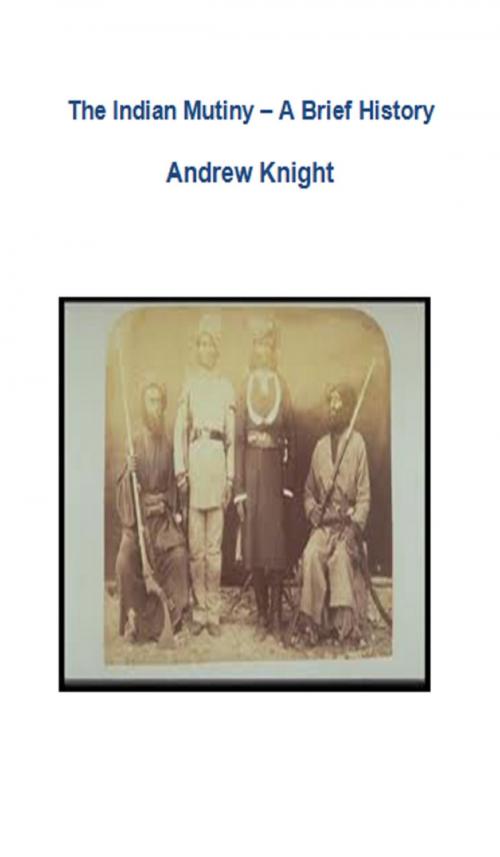| Author: | Andrew Knight | ISBN: | 9781301983391 |
| Publisher: | UK Independent Publishers | Publication: | January 29, 2013 |
| Imprint: | Smashwords Edition | Language: | English |
| Author: | Andrew Knight |
| ISBN: | 9781301983391 |
| Publisher: | UK Independent Publishers |
| Publication: | January 29, 2013 |
| Imprint: | Smashwords Edition |
| Language: | English |
The Indian Rebellion of 1857 began as a mutiny of sepoys of the East India Company's army on 10 May 1857, in the town of Meerut, and soon escalated into other mutinies and civilian rebellions largely in the upper Gangetic plain and central India, with the major hostilities confined to present-day Uttar Pradesh, Bihar, northern Madhya Pradesh, and the Delhi region. The rebellion posed a considerable threat to Company power in that region, and was contained only with the fall of Gwalior on 20 June 1858. The rebellion is also known as the India's First War of Independence, the Great Rebellion, the Indian Mutiny, the Revolt of 1857, the Uprising of 1857, the Sepoy Rebellion, and the Sepoy Mutiny. The Mutiny was a result of various grievances. However the flashpoint was reached when the soldiers were asked to bite off the paper cartridges for their rifles which were greased with animal fat namely beef and pork. This was, and is, against the religious beliefs of Hindus and Muslims. Other regions of Company-controlled India – such as Bengal, the Bombay Presidency, and the Madras Presidency – remained largely calm. In Punjab, the Sikh princes backed the Company by providing soldiers and support. The large princely states of Hyderabad, Mysore, Travancore, and Kashmir, as well as the smaller ones of Rajputana, did not join the rebellion. In some regions, such as Oudh, the rebellion took on the attributes of a patriotic revolt against European presence. Maratha leaders, such as the Lakshmibai, the Rani of Jhansi, became folk heroes in the nationalist movement in India half a century later; however, they themselves "generated no coherent ideology" for a new order. The rebellion led to the dissolution of the East India Company in 1858. It also led the British to reorganize the army, the financial system and the administration in India. India was thereafter directly governed by the crown as the new British Raj.
The Indian Rebellion of 1857 began as a mutiny of sepoys of the East India Company's army on 10 May 1857, in the town of Meerut, and soon escalated into other mutinies and civilian rebellions largely in the upper Gangetic plain and central India, with the major hostilities confined to present-day Uttar Pradesh, Bihar, northern Madhya Pradesh, and the Delhi region. The rebellion posed a considerable threat to Company power in that region, and was contained only with the fall of Gwalior on 20 June 1858. The rebellion is also known as the India's First War of Independence, the Great Rebellion, the Indian Mutiny, the Revolt of 1857, the Uprising of 1857, the Sepoy Rebellion, and the Sepoy Mutiny. The Mutiny was a result of various grievances. However the flashpoint was reached when the soldiers were asked to bite off the paper cartridges for their rifles which were greased with animal fat namely beef and pork. This was, and is, against the religious beliefs of Hindus and Muslims. Other regions of Company-controlled India – such as Bengal, the Bombay Presidency, and the Madras Presidency – remained largely calm. In Punjab, the Sikh princes backed the Company by providing soldiers and support. The large princely states of Hyderabad, Mysore, Travancore, and Kashmir, as well as the smaller ones of Rajputana, did not join the rebellion. In some regions, such as Oudh, the rebellion took on the attributes of a patriotic revolt against European presence. Maratha leaders, such as the Lakshmibai, the Rani of Jhansi, became folk heroes in the nationalist movement in India half a century later; however, they themselves "generated no coherent ideology" for a new order. The rebellion led to the dissolution of the East India Company in 1858. It also led the British to reorganize the army, the financial system and the administration in India. India was thereafter directly governed by the crown as the new British Raj.















